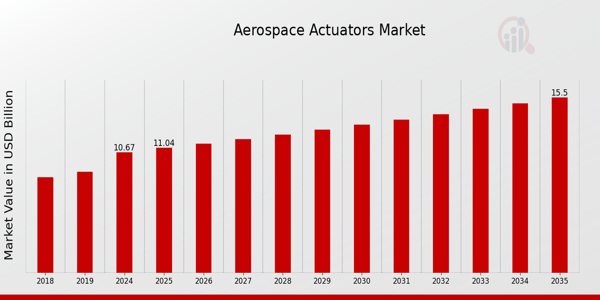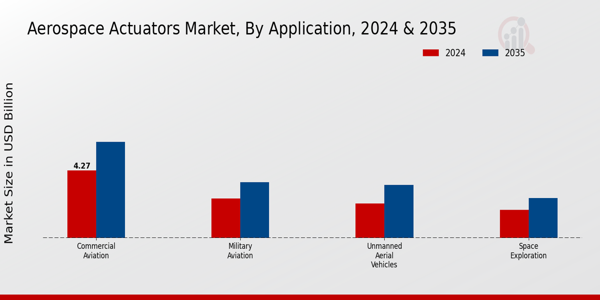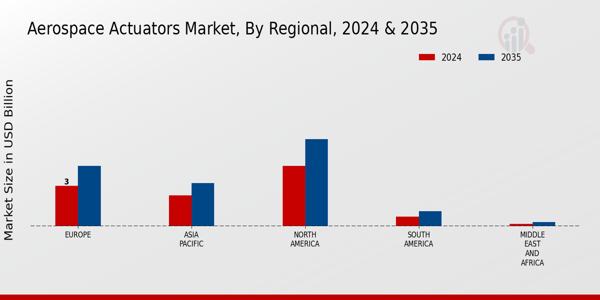Aerospace Actuators Market Summary
As per Market Research Future Analysis, the Aerospace Actuators Market was valued at 10.31 USD Billion in 2023 and is projected to grow to 15.5 USD Billion by 2035, reflecting a CAGR of 3.45% from 2025 to 2035. The market is driven by the increasing demand for lightweight components, technological advancements, and a focus on air travel safety.
Key Market Trends & Highlights
Key trends shaping the Aerospace Actuators Market include advancements in technology and a shift towards sustainability.
- The market is expected to grow from 10.67 USD Billion in 2024 to 15.5 USD Billion by 2035.
- Electric actuators are projected to increase by over 30% in aerospace applications by 2025.
- The Commercial Aviation segment was valued at 4.27 USD Billion in 2024, highlighting its dominance.
- North America is projected to grow from 4.5 USD Billion in 2024 to 6.5 USD Billion by 2035.
Market Size & Forecast
2023 Market Size: USD 10.31 Billion
2024 Market Size: USD 10.67 Billion
2035 Market Size: USD 15.5 Billion
CAGR (2025-2035): 3.45%
Largest Regional Market Share in 2024: North America.
Major Players
Key companies include Moog, Parker Hannifin, Northrop Grumman, Honeywell, and Raytheon Technologies.
Key Aerospace Actuators Market Trends Highlighted
On the global market for aerospace actuators, one key trend that is becoming increasingly prevalent is the growing need for actuator systems that are both lightweight and small. This trend is in line with the focus that the aircraft industry is placing on improving fuel efficiency and decreasing emissions, which is gaining popularity all around the world.
In the process of actuator design, there is a trend toward the use of modern materials and technologies. This transition is occurring as airlines and manufacturers strive to comply with severe environmental requirements and increase operating efficiencies. Additionally, there is an increasing tendency toward the incorporation of intelligent technology into actuator systems.
The Internet of Things (IoT) and automation are becoming increasingly popular. These have the potential to provide real-time data monitoring, predictive maintenance, and increased system performance, which ultimately results in airplanes that are safer and more dependable.
The growth of international air traffic and the associated need for the creation of new aircraft as well as the retrofitting of current fleets are two of the most important components that drive the industry. As a result of the growing demand for travel, notably in the Asia-Pacific region and in North America, there is a drive to build more complex aerospace systems, which in turn feeds the market for aerospace actuators.
Furthermore, the increasing investments in defense and military aviation are also driving the need for advanced actuators. This is because governments are placing a priority on enhancing their air force capabilities.
Focusing on electric and hybrid actuator systems, which provide improved energy efficiency and decreased operational costs, is one way to investigate potential opportunities in the worldwide market. As technology improvements continue to grow, manufacturers have the opportunity to capitalize on the trend toward automation by designing linked systems that improve the overall performance of airplanes.
A further benefit of the sustainability movement is that it opens up new opportunities for innovation, which in turn compels manufacturers to develop environmentally friendly actuator solutions. In general, the market is adjusting to these developments, which is resulting in enhanced designs and functions in aerospace actuators all over the world.

Source: Primary Research, Secondary Research, Market Research Future Database and Analyst Review
Aerospace Actuators Market Drivers
Increasing Demand for Lightweight Aerospace Components
The Aerospace Actuators Market is witnessing a significant shift towards lightweight materials as manufacturers aim to improve fuel efficiency and reduce emissions in the aviation sector. Research indicates that aircraft manufacturers are targeting a 20% reduction in weight for commercial aircraft components by 2030 to enhance performance and sustainability.
Major companies like Boeing and Airbus are already incorporating lighter materials and innovative designs that necessitate advanced actuators. This demand for lighter aerospace components is directly correlated with the rising need for cutting-edge actuation systems that provide precise control while minimizing weight.
With the International Air Transport Association (IATA) forecasting a surge in air traffic that will require increased aircraft efficiency, the demand for aerospace actuators is set to escalate globally.
Technological Advancements in Actuator Systems
The Aerospace Actuators Market is experiencing rapid growth propelled by advancements in actuator technology, such as the integration of electrification and smart technologies. A projected increase of over 30% in the use of electric actuators in aerospace applications by 2025 underscores this trend, driven by enhanced reliability and performance benefits.
Companies like Honeywell and Moog are leading the development of next-generation electromechanical actuators that offer improved response times, lower maintenance costs, and higher durability compared to traditional hydraulic systems. As aerospace systems continue to innovate, the need for advanced actuator technology that aligns with new design paradigms will propel market growth significantly.
Rising Focus on Air Travel Safety and Regulation Compliance
Safety remains a paramount concern in aviation, leading to strict regulatory measures and standards that drive the Aerospace Actuators Market. The International Civil Aviation Organization (ICAO) has reported a growing emphasis on enhancing safety protocols which requires frequent updates and retrofitting of aerospace components to comply with new regulations.
Additionally, recent data from the Federal Aviation Administration (FAA) indicates that compliance with safety mandates has led to a significant increase in actuator demand, projecting a rise of approximately 15% annually as safety protocols evolve.
Companies like Northrop Grumman and Thales have already begun adapting their products to meet these stringent safety requirements, thereby boosting the actuator market.
Aerospace Actuators Market Segment Insights
Aerospace Actuators Market Application Insights
The Aerospace Actuators Market exhibits significant growth within the Application segment, currently dominated by various key areas including Commercial Aviation, Military Aviation, Space Exploration, and Unmanned Aerial Vehicles.
In 2024, the Commercial Aviation segment was valued at 4.27 USD Billion, reflecting a substantial share of the overall market, underlining its importance due to the increasing demand for air travel and aircraft modernization.
The Military Aviation division reached a value of 2.48 USD Billion in the same year, emphasizing the necessity for advanced technology in defense applications, driven by global security concerns and modernization programs of military fleets.
The Space Exploration segment, valued at 1.76 USD Billion in 2024, highlighted the growing interest in private and governmental space missions, making it an essential contributor to the advancements in aerospace actuators, as they play a crucial role in spacecraft systems.
Meanwhile, Unmanned Aerial Vehicles reached a value of 2.16 USD Billion in 2024, showcasing their significance in various applications, from logistical support to surveillance, driven by advancements in automation and the increasing use of drones across industries.
Each of these segments reflected a distinct focus on technology and innovation, with investments geared towards enhancing performance, safety, and reliability in aerospace systems.
The impact of trends such as increased defense budgets in military aviation, the burgeoning commercial travel landscape, and the exploration of space for scientific research shape the Aerospace Actuators Market revenue, driving the demand across these application areas.
The upward trajectory in aerospace technology presents both opportunities and challenges, as manufacturers strive to meet regulatory standards and customer expectations while navigating the complexities of evolving aerospace frameworks.
The distinct valuation of each segment in the Aerospace Actuators Market statistics offered insights into market dynamics and allowed stakeholders to gauge where growth is happening and where investments can be made to capitalize on future trends.
The ongoing demand for efficient aerodynamic performance is critical in all segments, indicating the pervasive role that aerospace actuators will play in future developments across the global industry.

Source: Primary Research, Secondary Research, Market Research Future Database and Analyst Review
Aerospace Actuators Market Type Insights
The growth can be attributed to the increasing demand for advanced aerospace technologies and enhanced aircraft performance. Within the Type segmentation, the market encompasses Electrical Actuators, Hydraulic Actuators, and Pneumatic Actuators. Electrical Actuators are gaining traction due to their benefits of energy efficiency and reduced weight, making them ideal for modern aircraft systems.
Hydraulic Actuators maintain dominance in the industry due to their robust power capabilities, commonly preferred in applications requiring high force. Pneumatic Actuators, while less common, are primarily used in applications where rapid movements are essential, showcasing their unique advantages.
The combination of these types serves diverse functions, such as thrust vector control, wing deployment, and landing gear actuation, thereby contributing to the comprehensive advancement of aerospace systems.
As the market evolves, trends towards electrification and automation are likely to drive further innovations in these actuator types, fostering competitive dynamics and growth opportunities in the Aerospace Actuators Market.
Aerospace Actuatos Market Mechanism Insights
The Aerospace Actuators Market, focusing on the Mechanism segment, showcased remarkable characteristics in recent years. The market growth can be attributed to rising demand for efficient control systems in modern aircraft, along with advancements in automation technologies.
Within this Mechanism segment, several key types have emerged, notably Linear Actuators, Rotary Actuators, and Complex Multi-Function Actuators. Linear Actuators play a critical role in providing motion control for various applications, making them essential for precise operations in sectors like flight control and landing gear systems.
Rotary Actuators are significant due to their ability to enable rotational movements necessary in control surfaces. Meanwhile, Complex Multi-Function Actuators are increasingly dominating due to their versatility and capability to handle multiple functions simultaneously, which enhances system efficiency.
Collectively, these variations form a critical backbone for numerous aerospace applications, reinforcing the importance of the Aerospace Actuators Market within the broader context of global aerospace advancements.
Aerospace Actuators Market End-use Insights
The market is segmented into the Original Equipment Manufacturers and Aftermarket sectors, both of which play crucial roles in the supply chain. Original Equipment Manufacturers are essential as they contribute significantly to the new aircraft designs and advancements, focusing on innovative actuator technologies that enhance aircraft performance and efficiency.
Meanwhile, the Aftermarket segment is also significant as it addresses the maintenance, repair, and overhaul needs, ensuring that existing aircraft remain operational and safe. The growth in air travel, coupled with increasing demand for more fuel-efficient and technologically advanced aircraft, is driving the Aerospace Actuators Market revenue.
Additionally, the rising focus on upgrading older fleets with modern actuator systems opens up opportunities for expansion in both segments. While challenges such as regulatory compliance and supply chain disruptions exist, the ongoing advancements in actuator technology create a favorable environment for market growth and diversification.
Aerospace Actuators Market Regional Insights
The Aerospace Actuators Market witnessed considerable growth across various regions. In 2024, North America dominated the market with a valuation of 4.5 USD Billion, growing to 6.5 USD Billion by 2035, driven by robust advancements in aerospace technology and infrastructure.
Europe followed with a projected value of 3.0 USD Billion in 2024, expected to reach 4.5 USD Billion by 2035, reflecting strong demand for aviation products in the region. South America, with a valuation of 0.7 USD Billion in 2024, is anticipated to expand to 1.1 USD Billion by 2035, indicating emerging opportunities in aerospace development.
The Asia Pacific region was at 2.3 USD Billion in 2024 and forecasted to grow to 3.2 USD Billion by 2035, supported by increasing air travel and regional manufacturing capabilities. Lastly, the Middle East and Africa started at 0.17 USD Billion in 2024 and grow to 0.3 USD Billion by 2035, with potential fueled by investments in regional aviation.
These insights on the Aerospace Actuators Market segmentation revealed distinct growth drivers, where North America and Europe held significant market shares due to established industries, while emerging markets like Asia Pacific illustrated potential for rapid expansion.

Source: Primary Research, Secondary Research, Market Research Future Database and Analyst Review
Aerospace Actuators Market Key Players and Competitive Insights
The Aerospace Actuators Market is characterized by a dynamic competitive landscape where various players strive to capture market share through innovative technologies and strategic collaborations.
The increasing demand for lightweight components in aircraft, alongside the rising need for efficient flight control systems and enhanced safety features, continues to drive competition among market participants.
Companies are focusing on research and development initiatives to introduce advanced actuator technologies, including electric, hydraulic, and pneumatic actuation systems, aligning with evolving aerospace regulations and performance standards.
Additionally, partnerships with original equipment manufacturers (OEMs) and aftermarket services are pivotal in gaining competitive advantage and ensuring customer loyalty in this highly regulated market.
The interplay between established players and emerging startups also adds a unique dimension to the competitive field, making it essential for companies to adapt quickly to changing consumer preferences and technological advancements.
Moog is recognized for its strong presence in the Aerospace Actuators Market, offering a wide array of advanced actuation solutions tailored for both commercial and military aircraft. The company has built a reputation for high-quality products, including electro-mechanical actuators and fly-by-wire systems that enhance aircraft performance and reliability.
A key strength of Moog lies in its commitment to innovation and investment in R&D, allowing the company to stay ahead of market trends and continually improve its offerings. Furthermore, Moog has established a solid network of partnerships and collaborations, which not only strengthens its market position but also facilitates access to diverse customer segments.
This proactive approach in developing cutting-edge technologies while ensuring compliance with international aerospace standards reinforces Moog's competitive edge in the market.
Parker Hannifin stands out in the Aerospace Actuators Market due to its comprehensive portfolio of products and services that cater to various aerospace applications. The company specializes in hydraulic and electrical actuation systems, providing solutions that optimize performance and increase efficiency in aircraft operations.
Parker Hannifin's strengths include a robust global presence and a solid reputation for quality and reliability, allowing for a broad customer base that encompasses major aircraft manufacturers and airlines worldwide.
The company has strategically pursued mergers and acquisitions to enhance its capabilities and expand its market reach, ensuring it maintains a competitive stance.
Through continuous innovation and responsiveness to customer needs, Parker Hannifin effectively leverages its technological expertise and industry knowledge to deliver high-performance actuator solutions, positioning itself as a formidable player in the global aerospace market.
Key Companies in the Aerospace Actuators Market Include
- Moog
- Parker Hannifin
- CurtissWright
- Woodward
- Liebherr
- GKN Aerospace
- UTC Aerospace Systems
- Northrop Grumman
- Honeywell
- Raytheon Technologies
- Hamilton Sundstrand
- Rockwell Collins
- Boeing
- Thales Group
- Safran
Aerospace Actuators Market Developments
Recent developments in the Aerospace Actuators Market indicate a robust growth trend due to increasing demand for reliable and efficient flight control systems. Companies like Moog and Raytheon Technologies are at the forefront of innovation, with significant investments in Research and Development aimed at enhancing actuator performance.
In October 2023, Honeywell announced advancements in its actuator technologies for both commercial and military applications, reflecting a shift towards smarter, more integrated systems. Current affairs also highlight the increasing focus on sustainability within the industry, as firms like GKN Aerospace and Safran are developing lightweight materials to improve fuel efficiency.
Notably, in June 2023, Curtiss-Wright Corporation acquired a specialized actuator manufacturer, bolstering its presence in the aerospace sector and expanding its product portfolio. Additionally, the global market valuation of aerospace actuators is projected to grow due to the recovery of the aviation sector post-pandemic, with Northrop Grumman and Boeing also poised to benefit from this trend.
In recent years, there has been a notable rise in cooperation among these leading firms to address common challenges, paving the way for enhanced functionality and performance of aerospace actuators.
Aerospace Actuators Market Segmentation Insights
-
Aerospace Actuators Market Application Outlook
- Commercial Aviation
- Military Aviation
- Space Exploration
- Unmanned Aerial Vehicles
-
Aerospace Actuators Market Type Outlook
- Electrical Actuators
- Hydraulic Actuators
- Pneumatic Actuators
-
Aerospace Actuators Market Mechanism Outlook
- Linear Actuators
- Rotary Actuators
- Complex Multi-Function Actuators
-
Aerospace Actuators Market End-use Outlook
- Original Equipment Manufacturers
- Aftermarket
-
Aerospace Actuators Market Regional Outlook
- North America
- Europe
- South America
- Asia Pacific
- Middle East and Africa
|
Report Attribute/Metric
|
Details
|
|
Market Size 2023
|
10.31(USD Billion)
|
|
Market Size 2024
|
10.67(USD Billion)
|
|
Market Size 2035
|
15.5(USD Billion)
|
|
Compound Annual Growth Rate (CAGR)
|
3.45% (2025 - 2035)
|
|
Report Coverage
|
Revenue Forecast, Competitive Landscape, Growth Factors, and Trends
|
|
Base Year
|
2024
|
|
Market Forecast Period
|
2025 - 2035
|
|
Historical Data
|
2019 - 2024
|
|
Market Forecast Units
|
USD Billion
|
|
Key Companies Profiled
|
Moog, Parker Hannifin, CurtissWright, Woodward, Liebherr, GKN Aerospace, UTC Aerospace Systems, Northrop Grumman, Honeywell, Raytheon Technologies, Hamilton Sundstrand, Rockwell Collins, Boeing, Thales Group, Safran
|
|
Segments Covered
|
Application, Type, Mechanism, End-use, Regional
|
|
Key Market Opportunities
|
Growing demand for electric actuators, Replacement of aging aerospace systems, Expansion of UAV applications, Increasing focus on fuel efficiency, Advancements in automation technologies
|
|
Key Market Dynamics
|
Technological advancements, Increasing aircraft production, Demand for fuel efficiency, Growing military expenditure, Shift towards electric actuators
|
|
Countries Covered
|
North America, Europe, APAC, South America, MEA
|
Frequently Asked Questions (FAQ):
The Aerospace Actuators Market was valued at 10.67 USD Billion in 2024.
By 2035, the Aerospace Actuators Market is projected to reach a value of 15.5 USD Billion.
The anticipated CAGR for the Aerospace Actuators Market from 2025 to 2035 is 3.45%.
In 2024, North America held the largest market share at 4.5 USD Billion.
Europe is expected to contribute 3.0 USD Billion to the Aerospace Actuators Market in 2024.
The Commercial Aviation application is expected to be valued at 6.08 USD Billion in 2035.
Key players include Moog, Parker Hannifin, and Raytheon Technologies among others.
The Military Aviation segment is projected to reach 3.53 USD Billion in 2035.
Asia Pacific held a market size of 2.3 USD Billion in 2024.
Current global scenarios may present challenges such as supply chain disruptions and fluctuating demand.

















